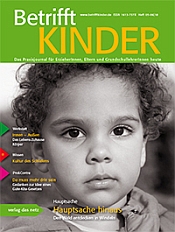Beiträge chronologisch
Exekutive Funktionen in der Montessori-Pädagogik
Inhaltsverzeichnis
Seite 6 von 6
LITERATURHINWEISE
Arnsten, A. F. (2009). Stress signalling pathways that impair prefrontal cortex structure and function. Nature Reviews Neuroscience, 10(6), 410-422Bernier, A., Carlson, S. M., & Whipple, N. (2010). From external regulation to self-regulation: Early parenting precursors of young children’s executive functioning. Child development, 81(1), 326-339
Blair, C. (2002). School readiness: Integrating cognition and emotion in a neurobiological conceptualization of children's functioning at school entry.,American psychologist,,57(2), 111
Blair, C., Knipe, H., & Gamson, D. (2008). Is there a role for executive functions in the development of mathematics ability?. Mind, Brain, and Education, 2(2), 80-89
Bläsius, J. (2015). Übungen des praktischen Lebens für Kinder unter 3 Jahren. Verlag Herder GmbH
Boyer, T. W. (2006). The development of risk-taking: A multi-perspective review. Developmental Review, 26(3), 291-345.
Carlson, S. M. (2005). Developmentally sensitive measures of executive function in preschool children.,Developmental neuropsychology, ,28(2), 595-616.
Carlson, S.M./Wang, T.S. (2005). Inhibitory control and emotion regulation in preschool children. In: Cognitive Development 22, 4, S. 489-510
Davidson, M.C./Amso, D./Anderson, L.C./Diamond, A. (2006): Development of cognitive control and executive functions from 4 to 13 years: evidence from manipulations of memory, inhibition, and task switching. In: Neuropsychologia 44, 11, S. 2037-2078
Diamond, A. (2016). Why improving and assessing executive functions early in life is critical
Diamond, A., Barnett, W. S., %omas, J., & Munro, S. (2007). Preschool program improves cognitive control.,Science,,318(5855), 1387-1388
Diamond, A. (2014a): Executive functions: Insights into ways to help more children thrive. In: Zero to three 35, 2, S. 9-17
Diamond, A. (2014b): Want to optimize executive functions and academic outcomes?: simple, just nourish the human spirit. In: Paper presented at the Minnesota Symposia on Child Psychology
Diamond, A. (2002). Normal development of prefrontal cortex from birth to young adulthood: Cognitive functions, anatomy, and biochemistry. Principles of frontal lobe function, 466-503
Diamond, A. (1990). Developmental time course in human infants and infant monkeys, and the neural bases of, inhibitory control in reaching. Annals of the New York Academy of Sciences, 608(1), 637-676
Diamond, A., & Doar, B. (1989). The performance of human infants on a measure of frontal cortex function, the delayed response task. Developmental Psychobiology: The Journal of 98 the International Society for Developmental Psychobiology, 22(3), 271-294
Diamond, A., & Lee, K. (2011). Interventions shown to aid executive function development in children 4 to 12 years old. Science, 333(6045), 959-964
Duckworth, A.L./Seligman, M.E. (2005): Self-discipline outdoes IQ in predicting academic performance of adolescents. In: Psychological Science 16, 12, S. 939-944
Feldman, R. (2009). %e development of regulatory functions from birth to 5 years: Insights from premature infants. Child Development, 80(2), 544-561
Flavell, J. H. (1986). %e development of children's knowledge about the appearance–reality distinction. American Psychologist, 41(4), 418
Garon, N., Bryson, S. E., & Smith, I. M. (2008). Executive function in preschoolers: a review using an integrative framework. Psychological bulletin, 134(1), 31
Gogtay, N., Giedd, J. N., Lusk, L., Hayashi, K. M., Greenstein, D., Vaituzis, A. C., ... & + Rapoport, J. L. (2004). Dynamic mapping of human cortical development during childhood through early adulthood. Proceedings of the National Academy of Sciences, 101(21), 8174-8179
Hendry, A., Jones, E. J., & Charman, T. (2016). Executive function in the $rst three years of life: Precursors, predictors and patterns. Developmental Review, 42, 1-33
Kochanska, G., Tjebkes, J. L., & Fortnan, D.R. (1998). Children's emerging regulation of conduct: Restraint, compliance, and internalization from infancy to the second year. Child development, 69(5), 1378-1389
Marinovic, V.; Pauen, S. (2012): Wie Kinder sich in Andere einfühlen können. TPS 7/2012, S. 34-37
Miyake, A./Friedman, N. P./Emerson, M. J./Witzki, A. H./Howerter, A./Wager, T. D. (2000): The unity and diversity of executive functions and their contributions to complex "Frontal Lobe" tasks: a latent variable analysis. In: Cognitive Psychology 41, 1, S. 49-100
Mischel, W., Shoda, Y., & Rodriguez, M. I. (1989). Delay of gratification in children. Science, 244(4907), 933-938
Moffit, T.E./Arseneault, L./Belsky, D./Dickson, N./Hancox, R.J./Harrington, H./Houtsa, R./ Poultonc, R./Roberts, B.W./Ross, S./Sears,M./Thomson, W.M./ Caspi, A. (2011): A gradient of childhood self-control predicts health, wealth, and public safety. In: Proceedings of the National Academy of Sciences 108, 7, S. 2693-2698
Mazzocco, M. M., & Kover, S. T. (2007). A longitudinal assessment of executive function skills and their association with math performance. ,Child neuropsychology,,13(1), 18-45
Thelen, E. (1984) in: Oerter, R. (2002). Entwicklungspsychologie. L. Montada (Ed.). Weinheim: Beltz PVU, S. 151
Rimm-Kaufmann, S.E./Curby, T.W./Grimm, K.J./Nathanson, L./Brock, L.L. (2009): The contribution of children’s self-regulation and classroom quality to children’s adaptive behaviors in the kindergarten classroom. In: Developmental Psychology 45, 4, S. 958-972
Rhoades, B.L./Greenberg, M.T./Domitrovich, C.E. (2009): The contribution of inhibitory control to preschoolers' social–emotional competence. In: Journal of Applied Developmental Psychology 30, 3, S. 310-320
Romer, D. (2010). Adolescent Risk Taking, Impulsivity, and Brain Development: Implications for Prevention Developmental Psychobiology, 52(3), 263-276. doi:Doi 10.1002/Dev.20442 Executive cognitive functions and impulsivity as correlates of risk taking and problem behavior in preadolescents. Neuropsychologia,47(13), 2916-2926
Sodian, B. (2011). %eory of mind in infancy. ,Child Development Perspectives,,5(1), 39-43
Sodian, B., Eisenbein, H., Kristen, S., & %oermer, C. (2010). Gedächtnis, Metagedächtnis und Theory of Mind.,Brennpunkte der Gedächtnisforschung, 107-128
Sternberg, R. J. (2008). Increasing fluid intelligence is possible after all. Proceedings of the National Academy of Sciences, 105(19), 6791-6792
+ St Clair-Thompson, H. L., & Gathercole, S. E. (2006). Executive functions and achievements in school: Shi"ing, updating, inhibition, and working memory.,Quarterly journal of experimental psychology,,59(4), 745-759
Valdez, P., Reilly, T., & Waterhouse, J. (2008). Rhythms of mental performance.,Mind, Brain, and Education,,2(1), 7-16
Übernahme des Beitrags mit freundlicher Genehmigung aus
DAS KIND 2020/Heft 66-67, S. 83-98
- Zuletzt bearbeitet am: Donnerstag, 05. Mai 2022 12:31 by Karsten Herrmann




